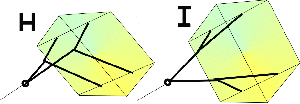- Rokkaku
1.7
-
- Wingspan:
- Height:
- weight:
- Sail area:
- Wing load:
-

-
|
-
-
- 144cm
- 170cm
- 0,45kg
- 2,0m²
- 0.23
|
-
|
-
-
- Min wind:
- Wind max:
- Min pull:
- Max pull:
-
- Line used:
-
-
- Spine
- Cross spars
|
-
-
- 3,6m/s
- 13m/s
- 0,8kg
- 15kg
-
- polyamid 70kg
-
-
- carbon Ø 10mm
- fiber glass Ø 8mm
-
|
- AD = 1700 mm
- FB = 1440 mm
- AG =HD = 350 mm
- AB = 800 mm
- BC = 1000 mm
- EB = 1753 mm
- JK = 600 mm
- LM = 500 mm
- Bridle:
- JR = KS = 1000 mm
- RL = SM = 1350 mm
- RT = ST = 500 mm
- Bow:
- upper spar p = 21 cm
- lower spar = 25 cm
-
|
- Rokkaku
2.0
-
- Wingspan:
- Height:
- weight:
- Sail area:
- Wing load:
-
-

|
-
-
- 170cm
- 200cm
- 0,55kg
- 2,7m²
- 0.20
|
|
-
-
- Min wind:
- Wind max:
- Min pull:
- Max pull:
-
- Line used:
-
- Spine
- Upper spar
- Lower spar
|
-
-
- 3 m/s
- 8 m/s
- 1kg
- 15kg
-
- polyamid 90kg
-
- carbon Ø 10mm
- carbon Ø 8mm
- fiber glass Ø 8mm
|
- AD = 2000 mm
- FB = 1700 mm
- AG = HD = 400 mm
- AB = 940 mm
- BC = 1200 mm
- EB = 2080 mm
- JK = 700 mm
- LM =600 mm
- Bridle:
- JR = KS = 1200 mm
- RL = SM = 1600 mm
- RT = ST = 600 mm
- Bow:
- upper spar p = 25 cm
- lower spar p = 30 cm
|

